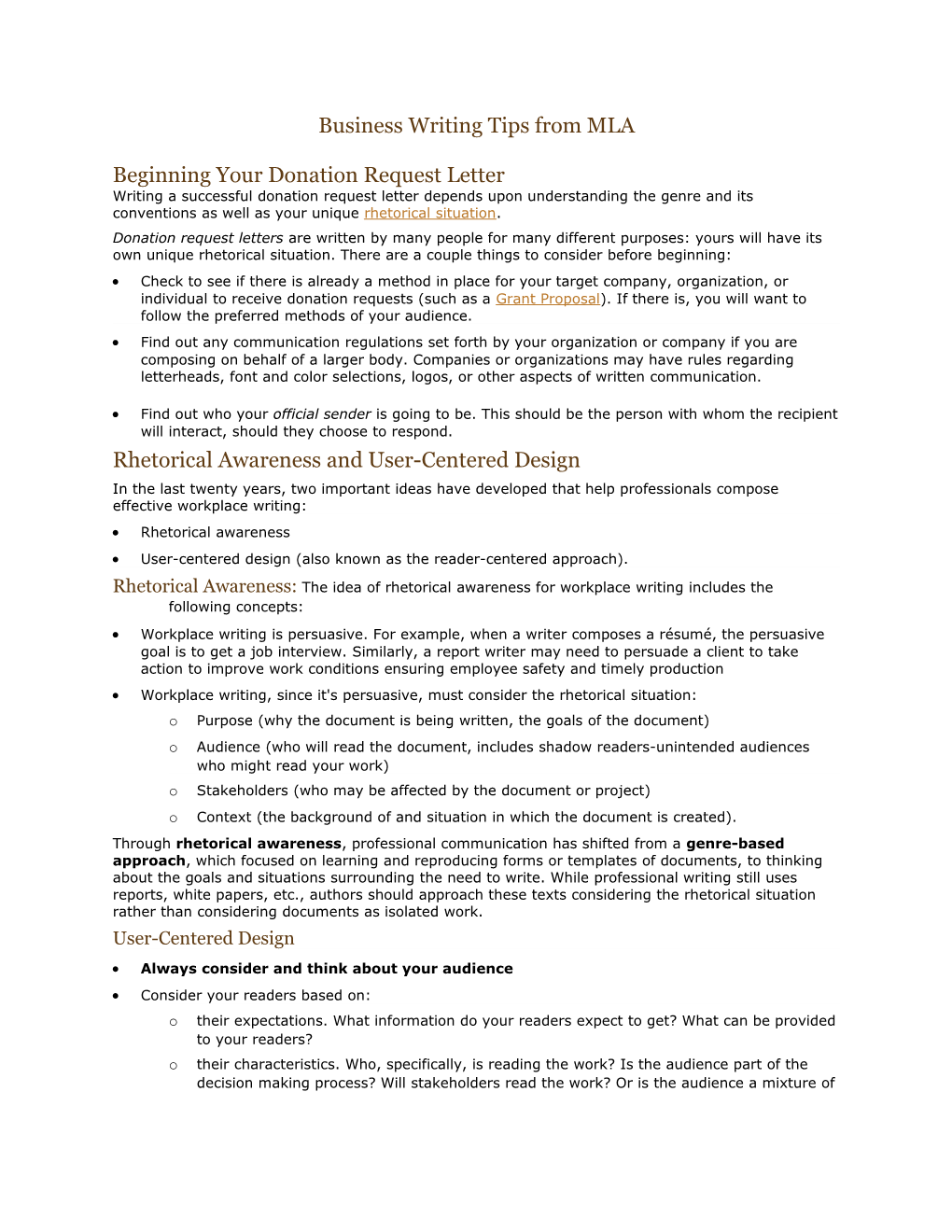Business Writing Tips from MLA
Beginning Your Donation Request Letter
Writing a successful donation request letter depends upon understanding the genre and its conventions as well as your uniquerhetorical situation.
Donation request lettersare written by many people for many different purposes: yours will have its own unique rhetorical situation. There are a couple things to consider before beginning:
- Check to see if there is already a method in place for your target company, organization, or individual to receive donation requests (such as aGrant Proposal). If there is, you will want to follow the preferred methods of your audience.
- Find out any communication regulations set forth by your organization or company if you are composing on behalf of a larger body. Companies or organizations may have rules regarding letterheads, font and color selections, logos, or other aspects of written communication.
- Find out who yourofficial senderis going to be. This should be the person with whom the recipient will interact, should they choose to respond.
Rhetorical Awareness and User-Centered Design
In the last twenty years, two important ideas have developed that help professionals compose effective workplace writing:
- Rhetorical awareness
- User-centered design (also known as the reader-centered approach).
Rhetorical Awareness: The idea of rhetorical awareness for workplace writing includes the following concepts:
- Workplace writing is persuasive. For example, when a writer composes a résumé, the persuasive goal is to get a job interview. Similarly, a report writer may need to persuade a client to take action to improve work conditions ensuring employee safety and timely production
- Workplace writing, since it's persuasive, must consider the rhetorical situation:
- Purpose(why the document is being written, the goals of the document)
- Audience(who will read the document, includes shadow readers-unintended audiences who might read your work)
- Stakeholders(who may be affected by the document or project)
- Context(the background of and situation in which the document is created).
Through rhetorical awareness, professional communication has shifted from a genre-based approach, which focused on learning and reproducing forms or templates of documents, to thinking about the goals and situations surrounding the need to write. While professional writing still uses reports, white papers, etc., authors should approach these texts considering the rhetorical situation rather than considering documents as isolated work.
User-Centered Design
- Always consider and think about your audience
- Consider your readers based on:
- their expectations. What information do your readers expect to get? What can be provided to your readers?
- their characteristics. Who, specifically, is reading the work? Is the audience part of the decision making process? Will stakeholders read the work? Or is the audience a mixture of decision makers, stakeholders, and shadow readers? What organizational positions does the audience hold and how might this affect document expectations?
- their goals. What are your readers planning to accomplish? What should be included in your documents so that your readers get the information they need?
- their context. For what type of situation do the readers need this information?
- Identify information readers will need and make that information easily accessible and understandable
- User-centered documents must be usable, so consider how the document will be used rather than just how it will be read. For example, if a writer wants information regarding MLA formatting for an essay, s/he needs this information quickly in order to start work. The MLA information must be easily accessible, so the author can find, read, and understand it to begin writing
- Make your documents persuasive (see Rhetorical Awareness above).
By adopting user-centered design, workplace writing focuses on the expectations, goals, situations, and needs of the readers. Closely related to user-centered design isparticipatory design, which aligns users with designers in a collaborative relationship.
See ourAudience Analysishandout for more information on researching your readers.
Below is one sample letter from the site: the most common format: block letter. The first address is the sender’s. If you have a letterhead with the address, omit this part. Note the Times New Roman font, a standard in the business world.
123 Winner's Road
New Employee Town, PA 12345
March 16, 2001
Ernie English
1234 Writing Lab Lane
Write City, IN 12345
Dear Mr. English:
The first paragraph of a typical business letter is used to state the main point of the letter. Begin with a friendly opening; then quickly transition into the purpose of your letter. Use a couple of sentences to explain the purpose, but do not go in to detail until the next paragraph.
Beginning with the second paragraph, state the supporting details to justify your purpose. These may take the form of background information, statistics or first-hand accounts. A few short paragraphs within the body of the letter should be enough to support your reasoning.
Finally, in the closing paragraph, briefly restate your purpose and why it is important. If the purpose of your letter is employment related, consider ending your letter with your contact information. However, if the purpose is informational, think about closing with gratitude for the reader's time.
Sincerely,
[This space is left blank so you can sign it here in pen]
Lucy Letter
For more on this:
